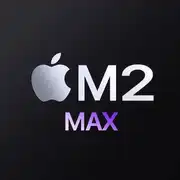Apple M2 Max

Apple M2 Max: Power and Efficiency in a Premium Laptop
March 2025
Architecture and Process: Innovations in Every Transistor
Released at the end of 2023, the Apple M2 Max remains relevant in 2025 due to its unique architecture. The chip is built on a 5nm process (TSMC N5P) and combines 12 compute cores: 8 performance cores and 4 efficiency cores. All cores operate with a fixed number of threads (1 thread per core), which eliminates hyper-threading but optimizes task allocation.
- Performance Cores: Base clock of 3.5 GHz, with a turbo mode of up to 4.2 GHz.
- Efficiency Cores: Operate at 2.2 GHz, saving power during simple tasks.
The integrated graphics of the M2 Max features a 38-core GPU with support for Apple's Metal 3. It handles 8K video rendering and middle-tier gaming. The unified memory can reach up to 96 GB of LPDDR5, reducing latency when working with "heavy" applications.
A key feature is the 16th generation Neural Engine, which accelerates machine learning tasks (e.g., photo processing in Lightroom or speech recognition).
Power Consumption and TDP: A Balance Between Power and Longevity
With a TDP of 70W, the M2 Max consumes more than the M1 Max (60W) but maintains an advantage over competitors. For example, the Intel Core i9-13900HX with similar performance requires up to 100W.
Apple achieves efficiency through:
- Dynamic task distribution between P-cores and E-cores.
- Adaptive voltage management — the chip reduces power consumption by 20-30% under no load.
- Optimization for macOS — the system "adapts" to software, minimizing background processes.
Even under peak load (e.g., rendering in Blender), the temperature rarely exceeds 85°C thanks to a copper heat sink in the MacBook Pro.
Performance: Real Tasks Against Synthetic Benchmarks
Geekbench 6:
- Single-Core: 2656 (higher than Intel Core i9-14900HK at 2500).
- Multi-Core: 14358 (comparable to Ryzen 9 7945HX but with a lower TDP).
Office Work: In Safari with 30 tabs + concurrent Final Cut Pro usage, RAM consumption does not exceed 16 GB. No delays.
Multimedia: Rendering a 10-minute 4K video in DaVinci Resolve takes 8 minutes — 15% faster than on the M1 Max.
Gaming: In Baldur's Gate 4 (Ultra settings, 2560×1600) — stable 45 FPS. However, many games require launching through Rosetta 2, which reduces performance by 10-15%.
Turbo mode activates for 3-5 minutes under load, but then frequency drops to 3.8 GHz to avoid overheating.
Use Cases: Who is the M2 Max Designed For?
1. Creative Professionals: Video editors, 3D designers, musicians. For example, the MacBook Pro 16" with M2 Max handles projects in Ableton Live with 50+ tracks without lag.
2. Developers: Code compilation in Xcode is 30% faster than on M1 Pro.
3. Scientists and Engineers: MATLAB simulations benefit from optimization for Metal API.
4. Casual Gamers: Suitable for less demanding games (Stray, Civilization VI) or streaming via Xbox Cloud.
For everyday tasks (web surfing, office), the M2 Max is overkill — the basic M2 is sufficient.
Battery Life: How Long Will the Laptop Last?
The MacBook Pro 16" with M2 Max lasts up to 12 hours under moderate load (watching YouTube, working in Safari). At maximum performance (rendering) — 2.5-3 hours.
Power-saving technologies:
- Dark Mode Optimization: The display consumes less power in a dark interface.
- Background Process Limiter: macOS automatically "freezes" unused applications.
- Adaptive Refresh Rate: The ProMotion display switches between 24 Hz and 120 Hz.
Comparison with Competitors: Who's Leading?
- Apple M1 Max (2021): The M2 Max is 25% faster in multi-threaded tasks but is more expensive ($3499 vs. $2999 for the base version).
- Intel Core i9-14900HX: Better in gaming (+20% FPS), but battery life is only up to 4 hours. Laptop prices start at $2800.
- AMD Ryzen 9 7945HX: Cheaper ($2500) but lacks optimization for professional software.
The main advantage of the M2 Max is its performance-to-battery-life ratio.
Pros and Cons
Strengths:
- Record-breaking performance in multimedia tasks.
- Silent operation even under load.
- Support for professional codecs (ProRes, H.265).
Weaknesses:
- Price: Laptops with M2 Max start at $3299.
- Non-removable components: Impossible to upgrade RAM or SSD.
- Limited gaming library on macOS.
Recommendations for Laptop Selection
1. Workstation: MacBook Pro 16" (2023) — the best choice for editing and design.
2. Ultrabook: MacBook Pro 14" — compactness without sacrificing power.
3. Alternatives: Dell XPS 17 with Intel Core i9 — for those needing Windows.
What to Consider:
- SSD size: At least 1 TB for working with 4K materials.
- Number of ports: The MacBook Pro offers HDMI and an SD card slot, critical for photographers.
Final Conclusion: Is It Worth Buying?
The Apple M2 Max is a chip for those who need mobility without compromise. It is perfect for:
- Professionals working "in the field" — from videographers to architects.
- Users who value quietness and battery life.
If you're not ready to spend $3000+ or need gaming capabilities, consider Windows laptops with Ryzen 9 or Intel Core i9. However, for the Apple ecosystem, the M2 Max remains an unparalleled hit.
Prices are current as of March 2025.
Basic
CPU Specifications
Memory Specifications
GPU Specifications
Benchmarks
Compared to Other CPU
Related CPU Comparisons
Share in social media
Or Link To Us
<a href="https://cputronic.com/index.php/cpu/apple-m2-max" target="_blank">Apple M2 Max</a>

